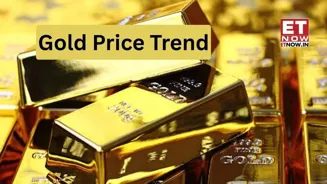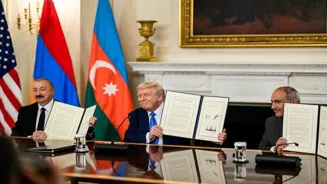Authored by Renisha Chainani, Head of Research, Augmont:
Gold has always been seen as a great source of protection in times of market and geopolitical uncertainty. When stock prices decline, global tensions
increase, or feel similar instability, many investors seek gold as an intrinsic asset for protection.
Unlike paper currency, gold is not linked to a government or sovereign currency, which makes it a safe-haven asset like many think of during certain crises like wars, inflation, or economic crashes. Gold’s inverse relationship with risk assets allows it to lower losses in times of market volatility. Recent global events such as the Russia-Ukraine war, Middle East conflicts and Tariff wars consistently reaffirm gold as a protective asset and identify its uses in a well-diversified portfolio.
Gold prices are currently near record highs, and while some would argue for price declines, two very strong global forces will continue to keep gold prices higher, at least in the short-term – economic uncertainty and Trump tariff uncertainty. These two dual forces are causing Gold to maintain the momentum:
Economic Uncertainty
Ongoing political tensions (e.g., Middle East, Russia-Ukraine), recession risks of the world’s major economies (e.g., U.S., Eurozone, China), and weak equity markets have investors buying gold as a safe-haven asset. Fraying public debt with slower global trade and volatile oil prices exacerbates the uncertain economic outlook and compels a further need to preserve capital.
Trump Tariff Uncertainty
In 2025, uncertainty surrounding tariffs from the Trump years–and also the potential to reintroduce or recover those existing tariffs–has returned investors once again to gold as a safe-haven asset. The fear of a global trade war, supply chain issues, and rising inflation has therefore shaken equity markets and also confidence in the economy. As the U.S. considers potential higher tariffs on goods coming from all countries, investors have hedged against potential devaluation of currencies or just exposure to more volatile conditions on a global scale. This uncertainty has lifted gold ETFs bullion demand and pushed gold prices higher. This event illustrates that, even during today’s temporarily unsteady economic and geopolitical environment, demand has behaved by predetermining transactional goals to hedge against risk in the form of gold.
Central banks’ dovish stance supports gold’s long-term outlook
Central Banks around the world are generally keeping a dovish tone, indicating lower interest rates or longer pauses with slowing growth and geopolitical risks. Gold’s long-term price outlook is greatly supported by monetary policy that is deemed accommodative.
When central banks keep interest rates low or lower interest rates, real yields decrease and therefore decrease the opportunity cost of holding a non-yielding asset, such as gold. Secondly, dovish monetary policy often weakens fiat currency, particularly the US dollar, which generally moves inversely to gold. As the US dollar weakens and inflates, gold becomes attractive to investors across the globe.
Additionally, central banks have emerged as large buyers of gold, especially in emerging markets such as China, India, and Turkey. Central banks for these emerging markets appear to have a central banking strategy to diversify their holdings away from dollar reserves to hedge against currency volatility and geopolitical instability.
The transition from central banks to gold began in the initial early months of 2022, once the war in Ukraine began. The world watched the US freeze Russia’s bond and cash reserves as other Western nations piled on more sanctions, including checking the use of many of Russia’s diplomatic privileges. Gold, as it is an asset, is liquid and less likely to be confiscated.
In this big picture story for gold, it stands out as an asset that historically has represented hard money against monetary debasement, inflation, and systemic financial risk. For investors, the continuing dovish shift in central bank monetary policy highlights the views of some as it relates to gold as to why it should be included as a key piece of a diversified long-term investment portfolio.
The emergence of digital gold
In a very short time, digital gold has emerged as a popular, convenient, safe and scalable investment asset class, especially among younger and technology-oriented investors. Digital gold is available through fintech apps and investment platforms, where users can buy fractional amounts of gold, as low as ₹1.
For a generation that is used to mobile banking and digital payments, digital gold is available to trade every second of the day, and it displays live market-linked pricing. Users can convert their holdings to cash or physical gold. Digital gold is backed by a holder of 24K gold that is stored at a safe location and insured by a reputable provider such as Augmont- Gold For All.
Younger investors are attracted to digital gold because of the low entry barrier, the lack of storage worry, and instant liquidity. There’s also the positive factor of SIPs, gifting options, and linking to the UPI ecosystem, all of which are compelling reasons for wealth creation and micro-saving.
As financial literacy increases and mobile penetration continues to grow, Digital Gold is quickly becoming a mainstream asset class in India—bringing together traditional investments with technology-based convenience. For the millennials and Gen Z, it is an easy way to get into the trusted safety of gold without the cumbersome physical ownership issues.
Strategic guidance on portfolio allocation
Gold is an important component of a balanced investment portfolio, especially as a hedge against volatility in the equity markets, inflation and currency devaluation. Gold has low correlations with traditional forms of financial assets, enabling sound diversification and risk reduction. Indicated below is a suggested allocation of gold within a “balanced” investment portfolio:
• Aggressive/Heavy Equity investors – 5-10 % to stabilise high volatility
• Conservative investors – 10-15% of total portfolio
• Retirees or risk adverse – 15-20% for capital preservation
These allocations will help cushion portfolios through rapid equity drawdowns and/or when the domestic currency depreciates, both of which typically serve to enhance gold’s value in INR terms.
Why Indian Investors Should Consider Gold Now
- Gold serves as a hedge against currency devaluation, inflation, and equity volatility.
- Although prices have cleared the ₹1 lakh/10g mark and many investors are worried about a peak, gold’s history as an asset class would suggest that if it has a chance to make a sustained run higher in price, it will consolidate before creating new highs.
- Indian investors can take advantage of diversifying their portfolios into gold by investing in Gold ETFs, or Digital Gold SIPs, instead of waiting for some “dip” that will never come.
To summarise, Gold is still a critical hedge against economic uncertainty, currency depreciation, and geopolitical risks. Given the current global economic recession fears, the uncertainty of the Trump tariffs, and dovish policies from central banks, it is likely to be supported at high levels of prices. For instance, the sustained buying of gold by Central Banks, as well as the emergence of Digital Gold, are significant, structural sources of demand for gold. If macroeconomic risks remain elevated, prices denominated in INR could feasibly target ₹1.10–₹1.15 lakh / 10 gram, over the following 12–18 months, but can spike higher during geopolitical tensions or US rate cuts. Indian investors will typically allocate 10 to 20% of their portfolio to Gold, either using Gold ETFs or Digital Gold SIPs for long-term stability in their portfolio.
Authored by Renisha Chainani, Head of Research, Augmont.
The views expressed in this article are those of the author and do not represent the stand of this publication.















